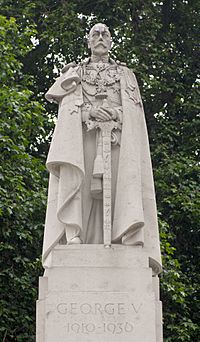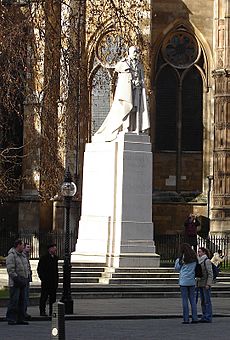Statue of George V, Westminster facts for kids
Quick facts for kids George V |
|
|---|---|
 |
|
| Artist | William Reid Dick |
| Year | 1947 (unveiled) |
| Type | Portland stone |
| Location | London, SW1 United Kingdom |
| 51°29′56″N 0°07′35″W / 51.498972°N 0.12634°W | |
The statue of George V is a sculpture found in Old Palace Yard, Westminster, London. It shows George V, who was the King of the United Kingdom. He was also the ruler of many countries that were part of the British Dominions and the Emperor of India. This statue was made before World War II. It was kept safe in a quarry during the war. People thought about putting it in other places, like Parliament Square. But it was finally shown to the public in 1947. You can find it across from the House of Lords.
About the Statue
The statue stands about 3 meters (10 feet) tall. It is made from a type of stone called Portland stone. You can see it just south of The Lady Chapel, Westminster Abbey. It is also directly across the street from the House of Lords. This statue is considered a special historical building. It became a "Grade II listed structure" on February 5, 1970. This means it is protected because it is important to history.
How the Statue Was Made
In March 1937, the Lord Mayor of London announced something exciting. He said that William Reid Dick was chosen to sculpt the statue of George V. Giles Gilbert Scott was picked to design the base, called a plinth. In October 1937, they announced where it would be placed. It would be on Abingdon Street, across from the House of Lords. The King George V National Memorial Committee organized the whole project.
The first design for the statue caused some talk. It was supposed to have a fancy Gothic roof over it. Some people said this roof would make the statue look too small. After asking the public what they thought, this roof was removed from the plans.
Some groups from the House of Commons and the House of Lords did not want the statue there. They worried it would mean tearing down some old houses nearby. A small model of the statue was shown in the House of Commons for members to see.
The Royal Fine Art Commission thought the statue should be in Parliament Square instead. But the statue was made before World War II started. It was too dangerous to bring it to London during the war. So, it was not put up until after the war ended.
The carving of the statue actually happened in the Portland quarry. This is where the stone came from. During the war, the statue was kept inside a tunnel in the quarry. This protected it from possible damage from German bombs. After the war, it was moved to the Tate Gallery. This was while the place for the statue was being made ready.
The statue was finally placed in the spot first planned. This was across from the House of Lords. To do this, one building, No. 5 Old Palace Yard, had to be taken down. King George VI officially showed the statue to the public on October 22, 1947. Many important people were there. These included Queen Elizabeth, Queen Mary, and Princesses Elizabeth and Margaret.
In 1968, a symbol was drawn on the side of the statue's base. It was the symbol for the Campaign for Nuclear Disarmament. This led to a question in the House of Commons about removing it. Dudley Smith MP asked about it.


